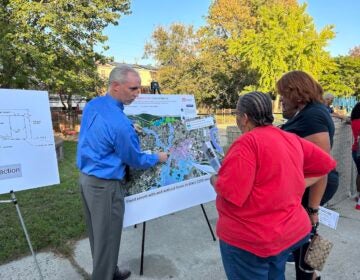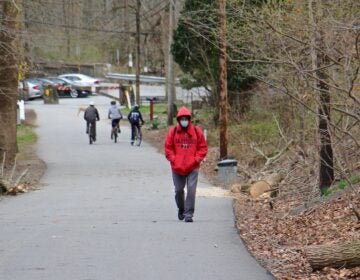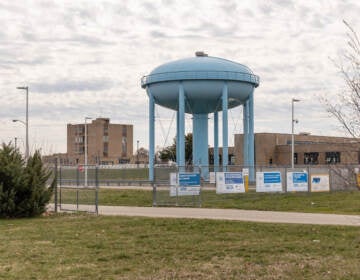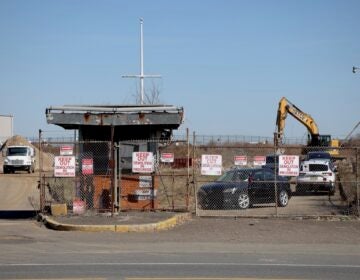A levee could be built in flood-prone Eastwick. Delaware County has concerns
The city of Philadelphia will not move forward with the project unless negative impacts on Delaware County are addressed, an official said.
Listen 1:03
Philadelphia's skyline is visible above the Eastwick tree line. (Eastwick Friends & Neighbors Coalition)
Have a question about Philly’s neighborhoods or the systems that shape them? PlanPhilly reporters want to hear from you! Ask us a question or send us a story idea you think we should cover.
Residents of Delaware County have serious concerns about a proposal to build a 1,400-foot levee over the county line in Philadelphia.
U.S. Army Corps of Engineers modeling shows the current proposal would dramatically reduce flooding during a 100-year storm in Eastwick, where repeated flooding has totaled cars, damaged homes, and left residents with emotional scars. But it would increase flooding slightly in small areas of Delaware County, by sending more water up- and down-stream during a flood.
“You can’t push that on Delaware County,” Sharon Hill resident Donna Hunter said after a public meeting about the proposal last week.
The current levee proposal is far from a final design, and it’s not certain whether it will be built. Army Corps officials are currently looking for ways to eliminate the negative impacts and gathering public input. They heard from Delaware County residents for the first time last week at a public hearing in Sharon Hill — where reactions to the proposal were mostly negative.
The proposed $13 million levee would stretch along Cobbs Creek in Eastwick, looking like a 15-foot-tall earthen embankment. It would withstand a 100-year storm without overtopping, benefitting around 2,400 homes in Eastwick, according to the Army Corps. The agency estimated it would prevent on average over $4 million in flood damage to infrastructure including homes, roads, and power lines per year, from 2030 to 2080.
But in its current design, the levee could cause additional flooding for as many as 328 structures near the Cobbs and Darby creeks in Delaware County, according to the Army Corps’ modeling.
This impact could range from “tiny differences” to roughly 1.2 feet of additional flooding during a 100-year flood — at locations such as the Hook Road bridge over Darby Creek, said Army Corps spokesperson Stephen Rochette.
Sharon Hill resident Carolyn Garrett worries this could disturb the nearby Mount Lawn Cemetery, where famed blues singer Bessie Smith is buried.
“Hook Road already floods,” she said after Thursday’s meeting. “What’s going to happen to them?”
Army Corps officials have said the levee would not cause any buildings in Delaware County that currently stay dry during a 100-year storm to flood.
Still, Delaware County residents and elected officials worry the so-called “induced flooding” could cause them to need expensive flood insurance, could lower their property values, or could lift toxins from nearby industrial sites.
Garrett, now a resident of Delaware County, said she lived in Eastwick in 1999 when Hurricane Floyd devastated the neighborhood.
“The … flood insurance was astronomical, and some people ended up not even being able to sell their homes,” Garrett said. “That is the kind of situation that I don’t want to happen here.”
The soonest the levee could begin construction would be in four to five years, according to the Army Corps. But there are several hurdles the project would need to clear first.
The city of Philadelphia would need to sign off on the plan and pay for part of it. City officials have said they’ll seek approval from the community before doing so.
“We cannot move forward until we have addressed the induced flooding,” said Korin Tangtrakul, who manages place-based initiatives with Philadelphia’s Office of Sustainability, during last week’s meeting.
The Army Corps is looking at complementary measures — like dredging streams or creating new wetlands — to eliminate the induced flooding in Delaware County. Because of the induced flooding, the Corps views the current Eastwick levee proposal as a “work in progress,” but would need a “complete plan” in order to build anything, Rochette, the spokesperson said.
“We want a complete solution that doesn’t just take a problem from one location and move it to another,” Scott Sanderson, chief of coastal planning with the Army Corps in Philly, said at Thursday’s meeting.
Getting access to land on which to build the levee could present another challenge.
The levee would be built mostly on city and privately owned land in Philly, but would also stretch onto a parcel owned by Darby Township in Delaware County, according to a real estate acquisition assessment done for the project.
“The affected municipalities would have to be willing to give that [real estate] easement in order to construct the project,” Sanderson said.
Gina Burritt, director of Delaware County’s Planning Department, said in an interview before Thursday’s meeting that her office wants to see Eastwick’s flooding problem solved — but is concerned about the levee’s potential to worsen flooding in Delaware County and about which municipality would pay for measures that reduce this impact. She wants to see the Army Corps expand its study area and provide more detail about the levee’s possible impacts.
“There’s just not enough information to know exactly what’s happening,” Burritt said.
Tammi Fleming, who moved to Delaware County after surviving Hurricane Katrina in New Orleans, asked whether other sources of federal money could be used to raise the budget for the levee project and design a solution that works for everyone.
“We should be careful not to be pitted against our neighbors in Eastwick,” she said. “It shouldn’t be an either-or situation.”
The Army Corps is accepting comments on the proposal through Nov. 30. Both Delaware County and city of Philadelphia officials are seeking an extension to the comment period.

Subscribe to PlanPhilly
WHYY is your source for fact-based, in-depth journalism and information. As a nonprofit organization, we rely on financial support from readers like you. Please give today.








